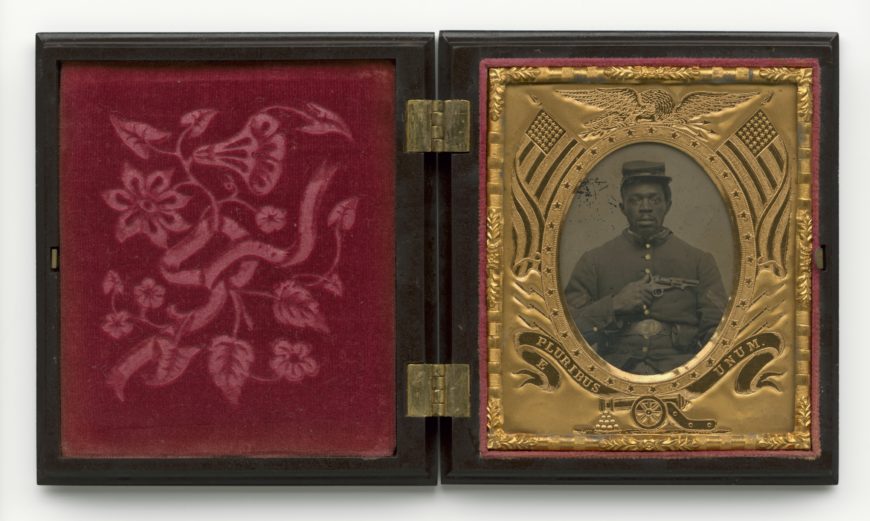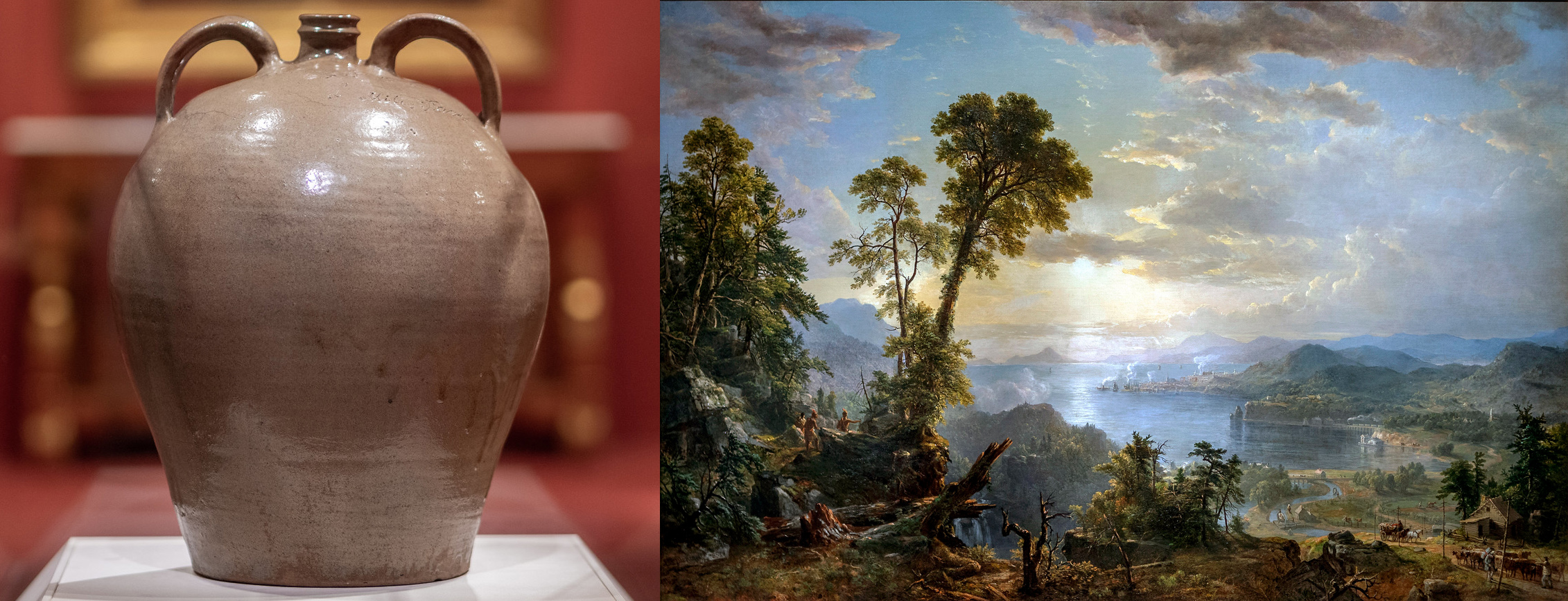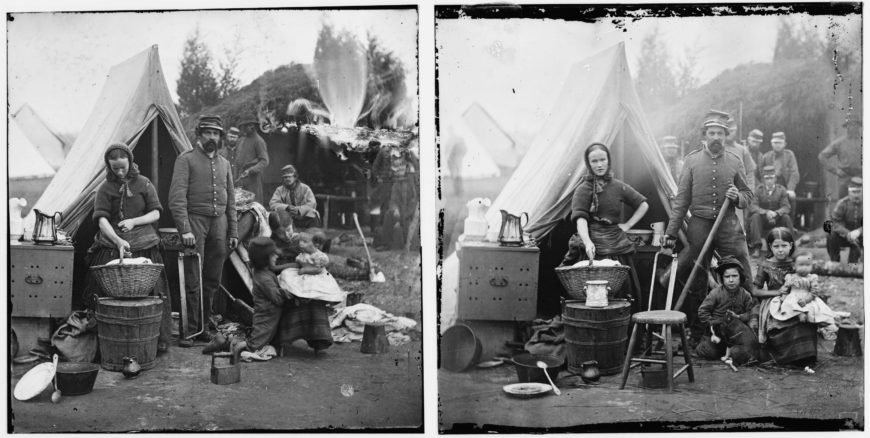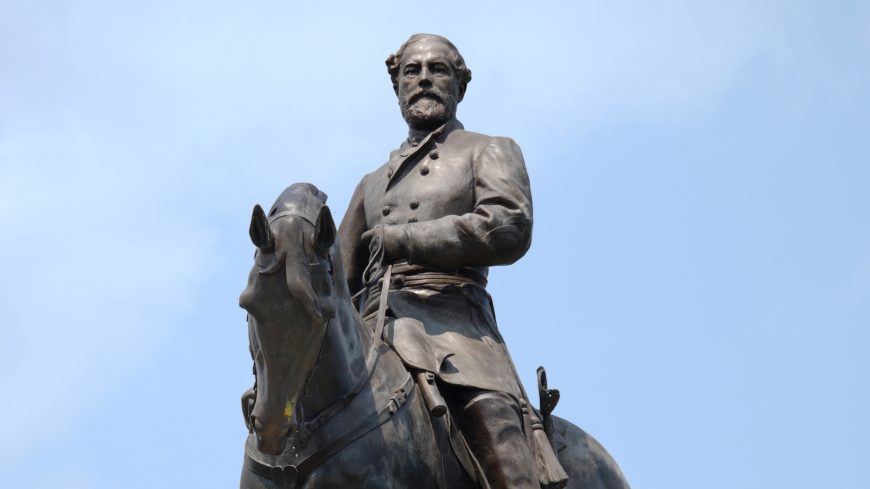These questions can support class discussion and debates, research, and essay writing. Use them after reading the essays and watching the videos from the U.S. Civil War in Art. You may also want to review the image galleries for the causes, experiences, and commemoration of the war to inform your responses.

Hand-colored tintype with cover glass of an unknown Black U.S. soldier, in black thermoplastic case with brass hinges and red velvet liner, c. 1861-65 (Smithsonian National Museum of African American History and Culture)
Global questions covered by all U.S. Civil War in Art essays and videos
- How was the development of photography and lithography important to the issues that caused the Civil War? How did they shape people’s experiences of the war?
- How do surviving photographic and lithographic sources inform our understanding of the Civil War today?
- How have Black and Indigenous peoples been left out of, erased from, or further marginalized by the visual record of the 19th century? And, what is the impact of this treatment on Black and Indigenous peoples today? In what ways are contemporary artists addressing these issues today?
- Is there a single image in the U.S. Civil War in Art that stood out to you that expresses your understanding of the Civil War, or pushed you to understand the war in a new way?
- Identify two images from the U.S. Civil War in Art that clearly demonstrate the power inequities and divisions that defined the Civil War. Provide an explanation of your choices.
- Compare two or more images of the same subject related to the U.S. Civil War. What new understandings do you gain about the subject, the war, and the work of visually representing the events and issues related to the war?

Left: David Drake, Doubled-handled Jug (Lewis J. Miles Factory, Horse Creek Valley, Edgefield District, South Carolina), 1840, stoneware with alkaline glaze, 44.13 x 35.24 cm (Virginia Museum of Fine Arts, photo: Steven Zucker, CC BY-NC-SA 2.0); right: Asher B. Durand, Progress (The Advance of Civilization), 1853, oil on canvas, 148.43 x 208.92 (Virginia Museum of Fine Arts)
Questions related to “Causes of the war” essays and videos
- What do works of art reveal about the deep divisions that led to the Civil War?
- How were enslaved people portrayed in images? Who portrayed them? Was there self-portrayal? Who was the audience for such images? Why were the images made?
- What can we learn about the practices and experiences of enslavement from visual imagery? What can’t we learn?
- Images were rare in the 19th century compared to today. Why were they rare? Did this rarity have an impact on perceptions of the institution of slavery?
- Why were images by white artists, like Eyre Crowe, that promoted abolition still showing slavery as relatively pretty?
- What made the visual comparison of enslavement with industrialization an effective argument for pro-slavery advocates?

Tent life of the 31st Penn. Inf. (later, 82d Penn. Inf.) at Queen’s farm, vicinity of Fort Slocum, Washington, District of Columbia (detail), 1861, two wet collodion glass negatives, (Library of Congress)
Questions related to “Experiences of the war” essays and videos
- Knowing that the visual and material record of the war is incomplete, what questions can we ask of what we see and don’t see in the record to avoid misinterpretation? Can you ask those same questions about images in our contemporary world?
- What does the visual record tell us about the experiences and impacts of the war for families? What does it leave out?
- How were images constructed during the Civil War to shift whites’ attitudes and beliefs about the capabilities and humanity of Black men and women over the course of the war?
- How do images of men and women from the time of the war reveal the complexity of their respective experiences of the conflict? How do 21st-century ideas about gender influence the way we interpret these images?
- Based on evidence from visual images from the U.S. Civil War in Art, how did the events of the Civil War affect the socio-economic or physical boundaries that separated groups of people? How did the events of the war create opportunities for people to forge new identities?
- What did it mean to be a soldier in the U.S. Civil War? How were soldiers represented and understood via visual culture of the time?

Antonin Mercié, Robert E. Lee Monument, 1890, bronze (removed from Monument Avenue, Richmond Virginia, September 9, 2021; photo: Steven Zucker, CC BY-NC-SA 2.0)
Questions related to “Commemorating the war” essays and videos
- Why does art commemorating the Civil War matter?
- How can we make more visible the neglected histories of the Civil War that monuments have not addressed?
- Why did commemoration of the Civil War matter to the people who made, financed, or looked at such art at the time of its creation?
- Does commemorative art of the Civil War continue to matter to people today?
- Why do you think there has been resistance in commemoration efforts, in both the North and the South, to acknowledging slavery as a primary cause of the war? Use visual images and material culture to support your answer.
- Whose voices and images ought to be celebrated in public art and memorials?
- The continued display of certain Civil War monuments has been questioned in recent years. How does a community determine when a given monument is deemed harmful? What options should be considered for the future of such monuments?
- How have artists today reflected on the erasures, the gaps, the biases, and the mythologies of the visual record of the Civil War? What other ideas do you have for making art that reclaims marginalized narratives?
- How have visual images of Abraham Lincoln shaped your understanding of his life and presidency?
- How have visual representations of notable figures from the mid-19th century (such as Abraham Lincoln), made in the years since the war, reflected changes in their reputation over time?
- What were the challenges and opportunities faced by the artists who depicted emancipation in monuments or other artworks? How did they respond to these challenges and opportunities?
- How did visual art contribute to the longevity of the Lost Cause mythology? What should be done, if anything, with Confederate symbols today? Based on your answer, describe the impact you hope these actions would have.




